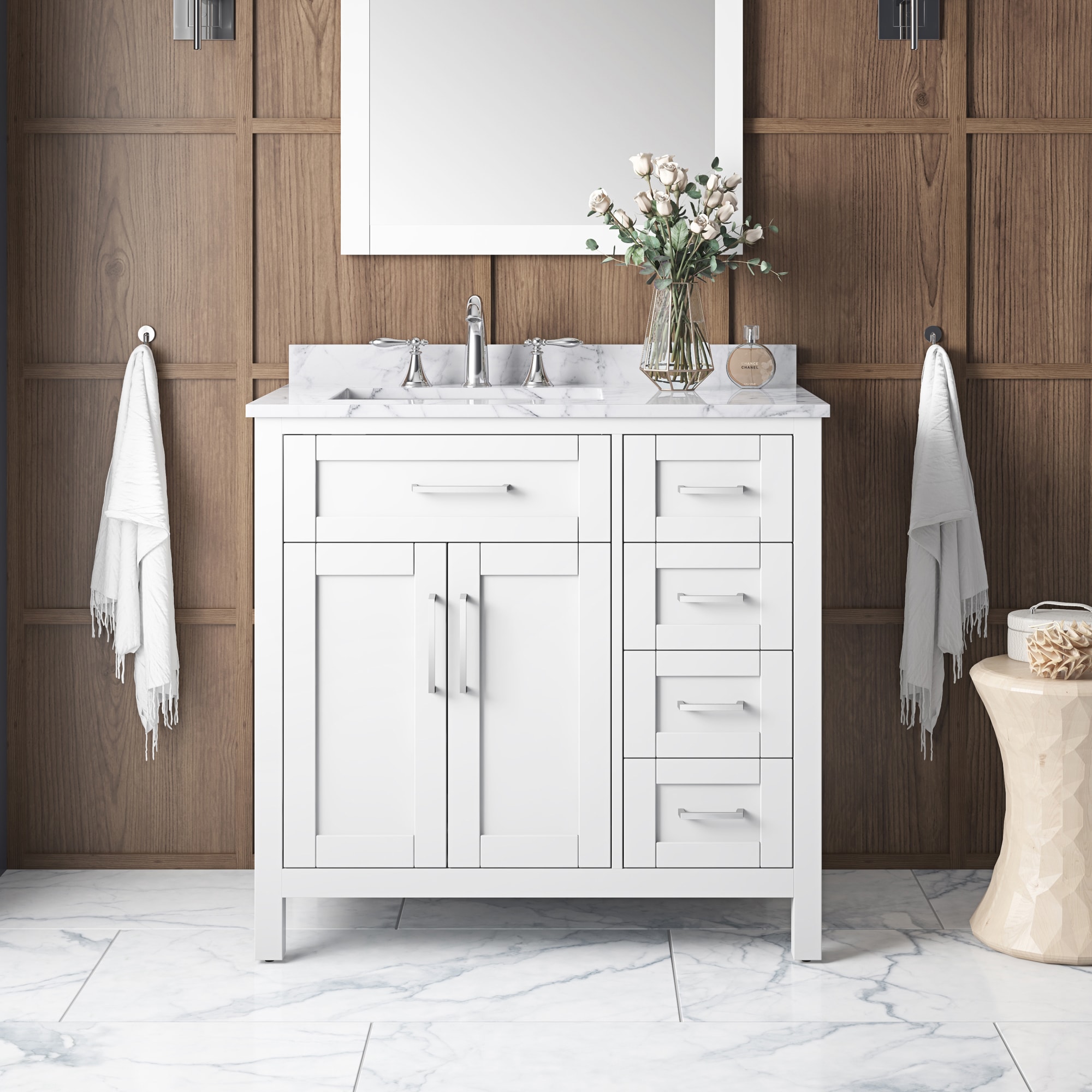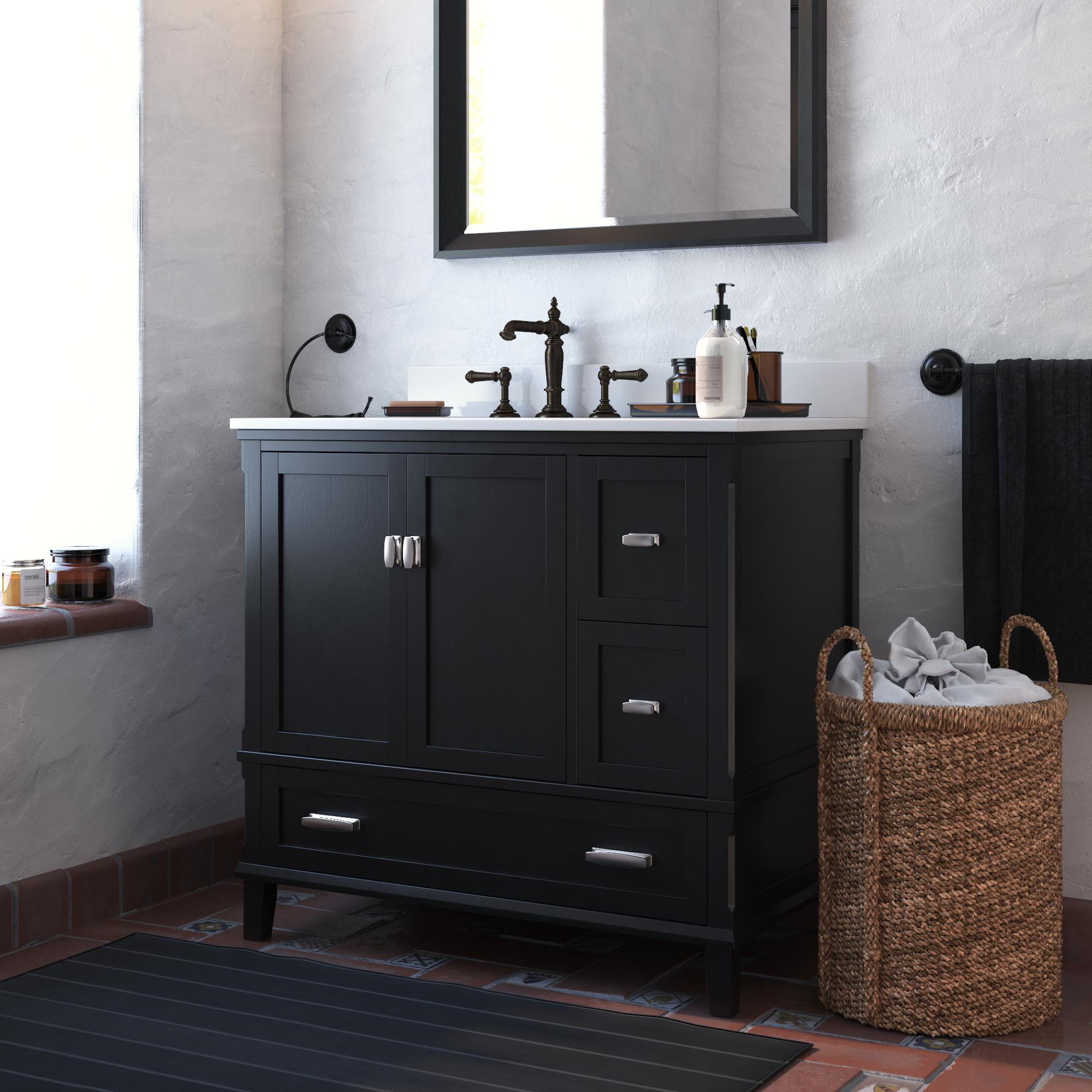Understanding the 36 x 18 Deep Bathroom Vanity

A 36 x 18 deep bathroom vanity offers a substantial amount of storage space and a generous countertop area, making it a popular choice for bathrooms of all sizes. Understanding the dimensions and features of this type of vanity is crucial in determining its suitability for your specific needs and bathroom layout.
Dimensions and Functionality
The dimensions of a 36 x 18 deep bathroom vanity refer to its width and depth. A 36-inch width provides ample counter space for placing toiletries, styling products, and decorative items. The 18-inch depth offers significant storage capacity, accommodating larger items like towels, hairdryers, and even small appliances. This depth allows for deeper drawers and cabinets, providing more vertical space for organization.
Advantages of a Deep Vanity
- Increased Storage: The extra depth provides more space for storing toiletries, towels, and other bathroom essentials, keeping your countertop clutter-free and your bathroom organized.
- Enhanced Functionality: The deep drawers and cabinets offer ample space for organizing and storing items of varying sizes, improving functionality and making it easier to find what you need.
- Improved Aesthetics: A deep vanity can create a more spacious and luxurious feel in the bathroom, especially when paired with a large mirror and ample lighting.
Disadvantages of a Deep Vanity, 36 x 18 deep bathroom vanity
- Space Requirements: A deep vanity requires more floor space than a standard vanity, which can be a constraint in smaller bathrooms.
- Potential for Clutter: While offering ample storage, a deep vanity can also become a haven for clutter if not organized effectively.
- Cost: Deep vanities tend to be more expensive than standard vanities due to the increased material and manufacturing costs.
Common Features and Components
- Drawers: Deep vanities typically feature multiple drawers, often with soft-close mechanisms for smooth operation and quiet closing.
- Doors: Some vanities have doors that open to reveal additional storage space. These doors can be hinged or sliding, depending on the design.
- Countertop Materials: Countertops for deep vanities can be made from various materials, including granite, marble, quartz, laminate, and wood. The choice depends on factors such as durability, aesthetics, and budget.
- Sinks: Deep vanities often accommodate larger sinks, providing more space for washing and rinsing.
- Hardware: The hardware, such as handles and knobs, can enhance the vanity’s aesthetics and functionality. Options range from traditional to modern styles, allowing you to personalize the look of your bathroom.
Design Considerations for a 36 x 18 Deep Bathroom Vanity

A 36 x 18 deep bathroom vanity offers ample storage and counter space, making it an excellent choice for a variety of bathroom styles. When designing a bathroom around a 36 x 18 deep vanity, consider the following design elements to create a cohesive and functional space.
Design Styles
The design style of a 36 x 18 deep bathroom vanity can range from traditional to modern, depending on the overall aesthetic of the bathroom.
- Traditional: Traditional bathroom vanities often feature intricate details, such as carved wood, ornate hardware, and a classic silhouette. These vanities typically have a warm and inviting feel, complementing a traditional bathroom design.
- Modern: Modern bathroom vanities are characterized by clean lines, minimalist details, and sleek finishes. They often feature bold geometric shapes and a focus on functionality. These vanities complement a modern bathroom design with a contemporary feel.
- Contemporary: Contemporary bathroom vanities blend elements of traditional and modern design. They often feature simple lines, natural materials, and a focus on functionality. These vanities create a balanced and stylish look, suitable for a wide range of bathroom styles.
Countertop Materials
The countertop material for a 36 x 18 deep bathroom vanity should complement the overall design style and offer durability and water resistance.
- Granite: Granite is a natural stone known for its durability, scratch resistance, and variety of colors and patterns. It is an excellent choice for a traditional or contemporary bathroom vanity.
- Quartz: Quartz is an engineered stone that offers durability, scratch resistance, and stain resistance. It is available in a wide range of colors and patterns, making it suitable for any bathroom design style.
- Marble: Marble is a natural stone known for its elegance and beauty. It is a softer stone than granite or quartz, making it more susceptible to scratches and stains. However, it adds a luxurious touch to a traditional or contemporary bathroom vanity.
- Wood: Wood countertops offer a warm and natural feel. They are a good choice for a traditional or rustic bathroom vanity. However, wood countertops require regular sealing and maintenance to prevent water damage.
Bathroom Layout
A 36 x 18 deep bathroom vanity provides ample storage and counter space, allowing for a functional and organized layout. Here is an example of a bathroom layout with a 36 x 18 deep vanity:
- Vanity Placement: Place the vanity against a wall, leaving enough space for easy access from both sides. The vanity should be centered on the wall, ensuring a balanced look.
- Sink Placement: Choose a sink that complements the design style of the vanity and provides adequate space for handwashing. A single-bowl sink is suitable for a smaller bathroom, while a double-bowl sink is ideal for a larger bathroom.
- Mirror Placement: Place a mirror above the vanity to reflect light and create the illusion of more space. Choose a mirror that complements the design style of the vanity.
- Lighting: Install lighting above and on either side of the vanity to provide adequate illumination for grooming. Consider using a combination of overhead lighting and vanity lights for a balanced and functional lighting scheme.
- Storage: Utilize the storage space provided by the vanity drawers and cabinets to keep toiletries and other bathroom essentials organized. Consider adding a medicine cabinet above the vanity for additional storage.
- Accessories: Include bathroom accessories such as towel bars, tissue holders, and toothbrush holders to complete the bathroom layout. Choose accessories that complement the design style of the vanity.
Installation and Maintenance of a 36 x 18 Deep Bathroom Vanity

Installing a 36 x 18 deep bathroom vanity can be a rewarding DIY project, enhancing the functionality and aesthetics of your bathroom. This process involves careful planning, proper tools, and a step-by-step approach to ensure a successful installation. Once installed, regular maintenance is crucial to preserve its beauty and longevity.
Installing a 36 x 18 Deep Bathroom Vanity
The installation of a 36 x 18 deep bathroom vanity requires precise measurements, proper plumbing and electrical connections, and a secure mounting. Here’s a detailed breakdown of the process:
Preparing the Installation Area
- Clear the area: Remove any existing vanities, fixtures, or obstacles from the installation site. This ensures ample space for working and prevents damage to surrounding areas.
- Prepare the wall: Ensure the wall is level and smooth. Patch any cracks or unevenness using drywall compound. If necessary, install a moisture-resistant backer board for added protection.
- Mark the location: Measure and mark the desired location of the vanity on the wall, ensuring it’s centered and aligned with existing plumbing and electrical outlets.
Installing the Vanity
- Attach the vanity base: Position the vanity base on the marked location and secure it to the wall using appropriate screws or anchors. Ensure the base is level and stable.
- Connect the plumbing: Attach the vanity’s plumbing fixtures to the existing water supply lines and drain pipe. Use thread sealant tape or pipe dope to prevent leaks.
- Install the countertop: Place the countertop on the vanity base and secure it using clamps or screws. Ensure the countertop is level and flush with the vanity base.
- Install the sink: Position the sink on the countertop and secure it using appropriate mounting hardware. Ensure the sink is centered and properly sealed to prevent leaks.
- Install the faucet: Attach the faucet to the sink, following the manufacturer’s instructions. Ensure the faucet is securely mounted and properly connected to the water supply lines.
Connecting Electrical
- Locate the electrical outlet: Identify the nearest electrical outlet for the vanity’s lighting or electrical accessories.
- Install the electrical wiring: Run the electrical wiring from the outlet to the vanity, following proper safety guidelines. Ensure the wiring is securely connected and properly insulated.
- Install the electrical fixtures: Attach the vanity’s electrical fixtures, such as lights or outlets, to the wiring. Ensure the fixtures are securely mounted and properly grounded.
Ensuring Proper Installation
- Check for leaks: After connecting the plumbing, test for leaks by turning on the water supply and inspecting all connections.
- Check for stability: Ensure the vanity is securely mounted and stable by gently rocking it. If it wobbles, tighten the mounting screws or use additional supports.
- Check for level: Use a level to ensure the vanity base and countertop are level. If necessary, adjust the mounting screws or shims to achieve a level surface.
Maintaining a 36 x 18 Deep Bathroom Vanity
Regular maintenance is crucial to keep your vanity looking its best and functioning properly. Here’s a routine maintenance plan:
Cleaning
- Daily cleaning: Wipe down the countertop and sink with a damp cloth to remove dust and debris. Avoid harsh chemicals or abrasive cleaners that can damage the finish.
- Weekly cleaning: Use a mild soap and water solution to clean the entire vanity, including the base, drawers, and doors. Avoid using harsh chemicals or abrasive cleaners that can damage the finish.
- Monthly cleaning: Clean the vanity’s hardware, such as handles and knobs, with a mild soap and water solution. Dry thoroughly to prevent rust or corrosion.
Sealing
- Seal the countertop: Apply a sealant to the countertop every 6-12 months to protect it from water damage and stains. Follow the manufacturer’s instructions for sealant application.
Repairs
- Tighten loose screws: Regularly check for loose screws and tighten them as needed to prevent damage or instability.
- Replace damaged parts: If any parts of the vanity become damaged, replace them with new ones. Consult the manufacturer’s instructions or contact a professional for assistance.
